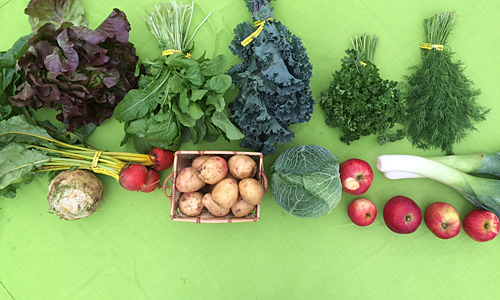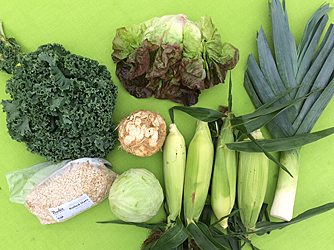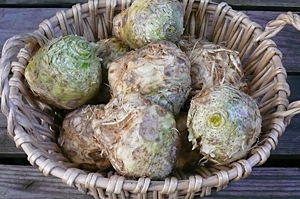
Standard Box
Curly Parsley 1 bu
Golden Beets with Greens 1 bu
Green Savoy Cabbage 1 hd
Red Kale 1 bu
Leeks 2
Arugula 1 bu
Celery Root
Dill 1 bu
Alaska Bloom Potatoes 3 lb
Apples 2 lb
Lettuce* 1 hd

In the Small Box
Rolled Oats 2 lb
Corn 4 ears
Leek
Green Cabbage 1 hd
Celery Root
Green Kale 1 bu
Lettuce* 1 hd
* From River Run Farm, Sequim
About Celery Root
“You can’t tell a book by its cover” goes the proverb. It couldn’t be more true in the case of celery root, aka celeriac or knob celery. On the outside, it looks like something from outer space. On the inside, it is a luscious cream color that also tastes fantastic prepared in a variety of ways.

If you come from Europe, or lived there for any length of time, celery root is no stranger to you. It has been a common cultivar there since the 17th century. Celerie remoulade is a classic cold French salad. The root is peeled and grated, soaked in diluted lemon juice or acidulated water, then dressed in a mustardy mayonnaise.
A simple and delicious favorite local way to eat celery root is roasted, perhaps as part of a roasted root medley. It cooks quicker than carrots or beets, so either roast it alone, or remove it early. Brush pieces with olive oil and sprinkle with salt and pepper before placing on a cookie sheet in a high oven (400°F). Watch it carefully to prevent burning.
Celery root is related to celery, but has been a distinct species since the time of the ancient Greeks. It’s a perfect substitute for starchier veggies, such as potatoes, and it has only 30 calories per serving and is an excellent source of dietary fiber. You can boil and mash it, grill it, cut it into long strips and French-fry it, or grate it raw onto a green salad. Add it to soups, stews or casseroles.
Peel it with a paring knife rather than a vegetable peeler because the outer layer can be fibrous. It’s worth every effort, because its flavor is so unique and delicate.
Celery root contains many anti-oxidants that possess anti-cancer properties and in particular may offer protection from colon cancer. It is a very good source of vitamin K that improves bone mineralization and protects against neurological damage to the brain. The root is also a very good source of essential minerals, such as phosphorus, iron, calcium, copper, and manganese. Further, it contains some of valuable B-complex vitamins and also provides moderate amounts of vitamin C.
Leek, Celery Root & Apple Soup
1 Tbsp. unsalted butter
1 Tbsp. olive oil, plus more for serving
2 large cloves garlic, sliced
1 rib celery, sliced
1 small onion, sliced
6 cups sliced leeks, white and light green parts
4 cups chicken or veggie stock
2 apples, peeled, cored and cut into 2” pieces
2 sprigs thyme
1 medium celery root, peeled and cut into 2” chunks
3/4 cup heavy cream or whole milk
Salt and white pepper, to taste
Parsley for garnish
Melt butter and oil in a large saucepan over medium heat. Add garlic, celery and onion and cook until onion is translucent. Reduce heat to low and add leeks. Cook, covered, until soft.
Add stock, 1 cup water, apples, thyme and celery root. Bring to a boil. Reduce to simmer and cook until celery root is tender. Remove from heat.
Discard thyme. Puree soup, in batches, if necessary. Add cream and season with salt and pepper. Serve with a drizzle of olive oil and garnish with parsley sprigs.
Beet Greens
Beet greens are more nutritious than the beets themselves! They have almost twice the potassium of beet roots and high amounts of beta carotene, an important antioxidant that helps fight numerous diseases. They also have good amounts of protein, phosphorus, and zinc, and are a great source of fiber. Packed with antioxidants, they’re high in vitamin B6, magnesium, copper, and manganese, and low in fat and cholesterol.
To store beets, separate the leaves from the root, leaving an inch or two of the stems. Remove any leaves that are damaged before storing the tops in a loosely wrapped plastic bag or a clean wet dish towel in the crisper section of the refrigerator, for no more than a few days. Roots should also be stored similarly—if left in the crisper unwrapped, they will quickly dehydrate and become soft.
Great ways to use fresh dill

- Add sparkle to a tuna sandwich.
- Enhance a cold gazpacho soup.
- Mix ¼ cup fresh dill with ¼ cup vinegar, 1 tsp. sugar, ½ tsp. salt, ¼ tsp. black pepper, and 2 Tbsp. olive oil. Add 2 sliced cucumbers, 1 cup sliced red onion, and 2 cut-up tomatoes. Toss, and let stand at least 15 minutes before serving.
- Got a favorite pureed carrot soup recipe? Be sure to garnish it with some delicate dill fronds for a treat that’s not only tasty, but visually appealing.
- Dill with salmon is a marriage made in heaven. Add finely chopped garlic, too!
- Add to Greek green salads, with romaine, sliced scallions and crumbled feta.
- Next time you make sourdough bread, throw in some olives and dill.
- Finely chop ½ cup dill and mix with 2-3 Tbsp. butter, salt, and pepper. For an incredible roasted chicken, use a spoon to get it under the skin of the breasts, thighs, and legs, and massage it around the meat. Stuff some into the cavity of the chicken with some lemon slices and garlic.
- Add to potato soup, or potato salad with lemon and green onion.
- Add to cole slaw, omelets, lentil dahl, borscht.
- Make dill sauce with 1/2 cup plain yogurt or sour cream, 1.5 Tbsp. Dijon-style mustard, 1 Tbsp. lemon juice, and 2 tsp. chopped, fresh dill. Chill before serving.
